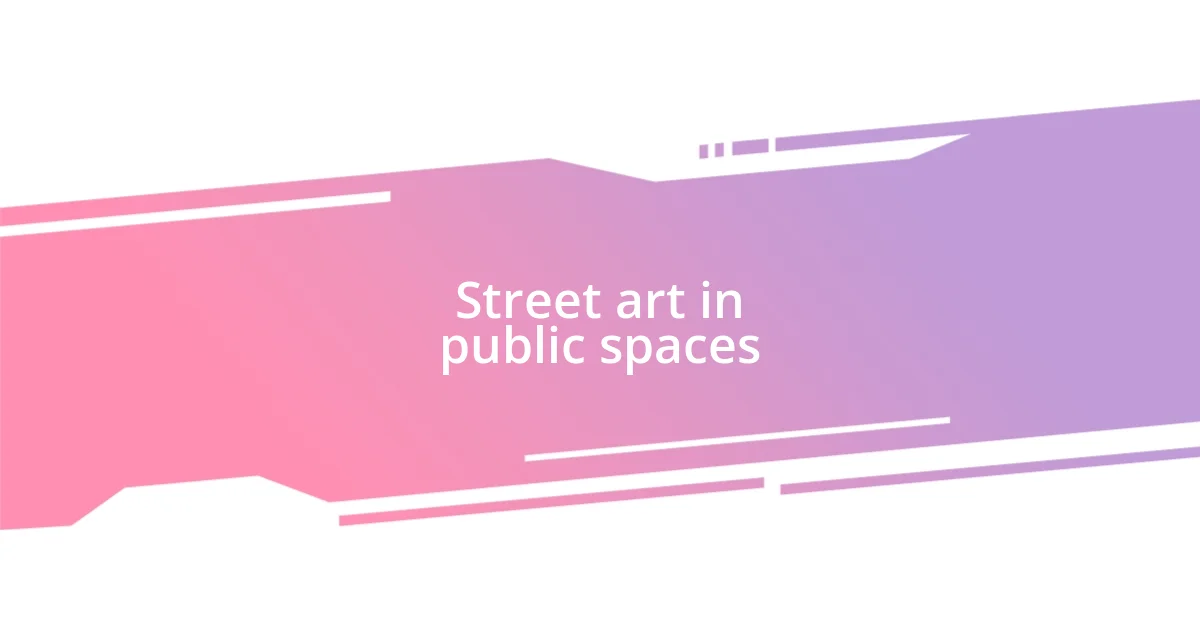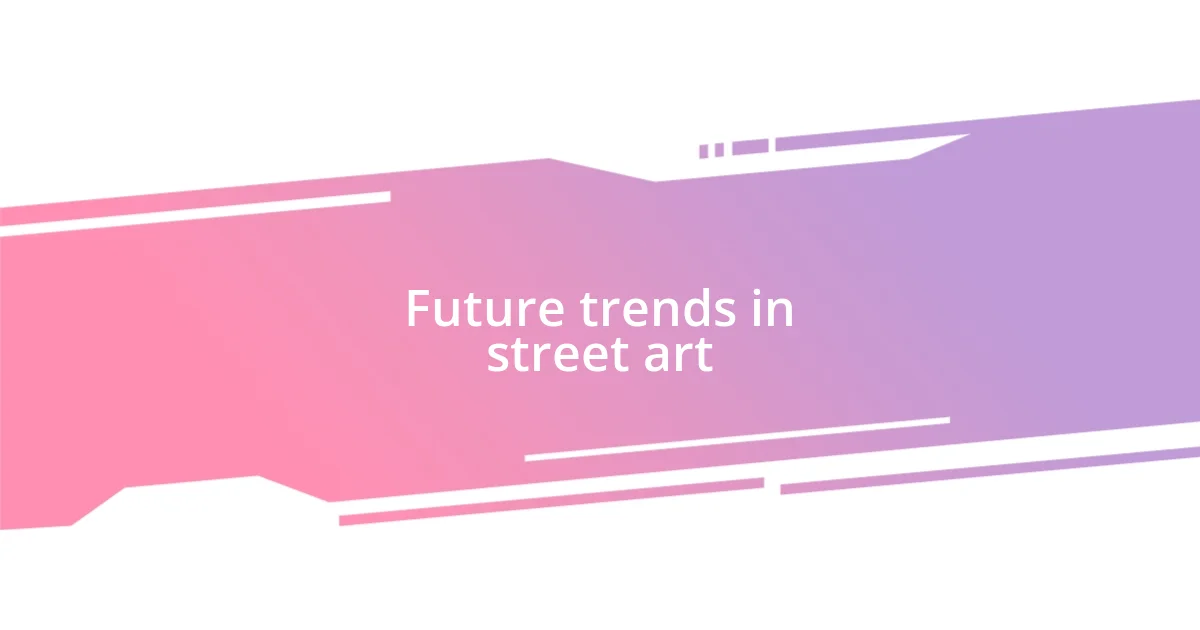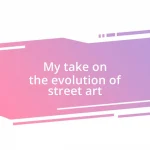Key takeaways:
- Street art has evolved from ancient civilization murals to a contemporary form of expression that addresses socio-political issues, notably influenced by artists like Banksy, Keith Haring, and Jean-Michel Basquiat.
- Technological advancements, such as augmented reality and social media, have transformed street art into an interactive experience, enhancing its accessibility and public engagement.
- Future trends in street art include a focus on sustainability and collaborative projects with communities, reflecting a growing awareness of environmental issues and the importance of local narratives.

History of street art
Street art has roots that trace back to ancient civilizations, where murals adorned the walls of cities, telling stories of culture and community. I remember strolling through the alleys of Lisbon, where the colors and characters seemed to whisper the city’s history, connecting past and present. Isn’t it fascinating how art can transcend time, creating a dialogue with observers through the language of imagery?
Fast forward to the late 20th century, and street art began to emerge prominently in urban environments, driven by a wave of rebellion against societal norms. Artists like Keith Haring and Jean-Michel Basquiat turned cityscapes into canvases, using their art to challenge ideas around race, culture, and identity. I often wonder if the graffiti I encountered in my teenage years echoed their sentiments—those vibrant tags had a voice of their own, didn’t they?
Street art wasn’t merely an aesthetic choice; it reflected the socio-political climate of its time, transforming the urban landscape into a living gallery. I recall seeing a powerful mural addressing social justice, the colors bleeding into my thoughts long after I left the spot. Why does it resonate so deeply? Perhaps it’s because street art has the remarkable ability to speak for those who often feel unheard, daring us to notice and question our surroundings.

Key artists who shaped it
When I think about key artists who shaped street art, a few names inevitably come to mind. Banksy, for instance, has revolutionized how we perceive this medium. His satirical and thought-provoking pieces challenge societal norms and politics, sparking conversations in both art circles and mainstream media. I remember coming across one of his stencils in an unexpected alleyway; it caught me off guard and made me smile while also provoking a deeper reflection on consumerism and social issues.
Other influential figures also deserve a spotlight for their contributions. Here’s a list of some artists who have made significant impacts on the evolution of street art:
- Keith Haring: Known for his vibrant, cartoonish figures, Haring’s work often tackled themes of love, sexuality, and AIDS awareness.
- Jean-Michel Basquiat: His unique blend of graffiti and neo-expressionism explored identity and race, capturing the complexity of urban life.
- Shepard Fairey: The creator of the iconic “Hope” poster for Barack Obama’s campaign, Fairey mixes propaganda and social activism into his art.
- Os Gêmeos: Brazilian twins who bring a whimsical style to street art, often incorporating elements of their culture and personal experiences.
- Invader: Famous for his mosaic tiles inspired by video game characters, he cleverly transforms urban landscapes into pixelated worlds.
Each of these artists not only pushed boundaries but also reflected their own experiences and beliefs through their work, shaping how we understand street art today. I often think about how their art creates a connection—a thread that ties together the stories of communities, struggles, and aspirations.

Evolution of styles and techniques
The evolution of styles and techniques in street art is truly a fascinating journey. In the early days, graffiti was predominantly a form of tagging—simple and often spontaneous. I remember taking my first stroll through the backstreets of Berlin, where the walls were adorned with vibrant tags, each a name or symbol that seemed to shout for attention. As I walked, I felt like a witness to an urban conversation, mere scrawls transforming into a powerful form of self-expression. Over time, street art transitioned into more complex forms, incorporating stencils, wheat-pasting, and even murals that transformed entire facades, creating immersive visual experiences. Isn’t it incredible how the medium has expanded?
With the advent of digital influences, artists began experimenting with techniques that blended traditional art forms with technology. I recall visiting an exhibition where augmented reality brought static images to life. When I pointed my phone at a mural, it animated the scene, creating a captivating interplay between reality and illusion. This merge of styles shows how street art evolves to reflect contemporary issues and technologies, inviting audiences to engage with it in new and dynamic ways.
Today, you can find a plethora of styles in street art, from photorealistic murals to abstract graffiti, with each piece telling its own story. Walking through the neighborhoods of São Paulo, I felt overwhelmed by the variety of techniques—some walls seemed to pulsate with energy, while others soothed with their craftsmanship. It made me realize that street art is more than just visual appeal; it’s a dialogue between artist and viewer, reflecting the complexities of identity, community, and cultural heritage.
| Style/Technique | Description |
|---|---|
| Tagging | Simple, often monochromatic signatures or logos that convey the identity of the artist. |
| Stenciling | A technique that uses a pre-cut template to quickly reproduce images or text, allowing for sharp, defined designs. |
| Muralism | Larger, elaborate artworks that transform public spaces, often conveying social or political messages. |
| Wheat-pasting | An adhesive technique for posting large printed artworks or designs to walls, enabling quick installation. |
| Digital integration | Utilizing technology, such as augmented reality, to enhance traditional street art, creating interactive experiences. |

Impact of technology on expression
Technology has dramatically reshaped the expression of street art, transforming it from a hidden underground phenomenon into a dynamic and accessible medium. I remember the first time I encountered a mural that employed QR codes, allowing viewers to engage with digital content linked to the artwork. It was like wandering into a gallery where every piece had a story to tell. This integration of technology has opened up new avenues for artists to convey their messages, making their work even more interactive and thought-provoking.
The rise of social media platforms has also played a crucial role in amplifying street artists’ voices. I’ve seen countless artists gain recognition and build communities around their work, all through platforms like Instagram. I recall fascinating interactions where I would come across a piece of street art online, only to discover later that it exists just around the corner from my home. The thrill of finding it in real life felt like a mini treasure hunt, allowing me to connect with both the artist’s intent and my local culture intimately.
Moreover, technology has birthed new forms of artistic expression that challenge the traditional boundaries of street art. While exploring a creative hub in my city, I stumbled upon a projection mapping art piece. As I watched the building come to life with colorful animations that danced across its surface, I couldn’t help but wonder—how might this technology change the way we perceive public art in the future? It’s clear to me that as technology evolves, it not only enhances the existing forms of street art but also invites us to rethink the very nature of expression in public spaces.

Street art in public spaces
Street art in public spaces transforms the urban landscape into a vibrant canvas for artistic expression. I’ll never forget the time I stumbled upon a massive mural in a forgotten alleyway in my city. This unexpected treasure, featuring a breathtaking blend of colors and characters, stirred something deep within me—a reminder that beauty can thrive even in the most overlooked places. Have you ever encountered a work of art that completely changed your perception of your surroundings? For me, that mural ignited a spark to explore every corner, searching for the hidden stories painted on the walls.
As I observed more pieces, I realized that street art serves as a social commentary about the environment and the issues that matter. I was moved when I saw a mural that addressed climate change; it depicted melting glaciers and endangered wildlife, creating a powerful visual narrative. It struck me how this artwork engaged passerby spectators, sparking conversations about responsibility and awareness in our communities. Don’t you think it’s fascinating how art can serve a purpose beyond aesthetics? It challenges us to reflect on the world we live in and inspires change with just a burst of color on a blank wall.
Public spaces provide a unique platform for street artists, as they reach a diverse audience—people from all walks of life. I recall watching a group of children marvel at a playful piece that illustrated local wildlife, their eyes wide with wonder and curiosity. In that moment, I thought about the importance of accessibility in art. Street art is truly democratic; it invites everyone in without the barriers of galleries or ticket prices. Isn’t it amazing how a simple wall can become a stage for creativity, connecting communities through shared experiences and emotions?

Cultural significance and social messages
Street art has a unique capacity to reflect the cultural pulse of a community, serving as a mirror for its values, struggles, and dreams. I vividly recall the time I encountered a series of striking pieces that confronted issues like racial inequality and poverty. Each mural was a powerful statement, layering voices of those often unheard. It made me ponder—how often do we overlook these stories in our daily lives? This artwork was a reminder that art can encapsulate the essence of social movements, urging us to acknowledge and address the challenges faced by our communities.
Additionally, the emotional weight of certain street pieces can be profoundly moving. I came across a wall embellished with poignant images honoring marginalized identities, complete with words of empowerment. Standing there, I felt a wave of solidarity wash over me—it was as if the artist was inviting everyone to share in a collective healing experience. Don’t you think it’s remarkable how art, even in public spaces, can engender empathy and understanding? These creations foster connections between strangers, weaving narratives that resonate deeply and encouraging unity amidst diversity.
In many cases, the messages conveyed through street art resonate far beyond their immediate environment, becoming part of a larger dialogue about societal change. A powerful example is the wave of works advocating for climate action that have emerged globally. I remember visiting an art festival where a giant mural depicted the ocean in decline, hauntingly beautiful yet chilling. It made me question—what role do we each play in this escalating crisis? This kind of thought-provoking artistry compels us not just to appreciate aesthetics but to reflect on our responsibilities toward the world we inhabit. Street art, in all its vibrancy, serves as both a commentary and a catalyst for social dialogue, inviting us to engage with the pressing issues of our time.

Future trends in street art
I believe we’re on the cusp of a fascinating transformation in street art, especially with the rise of digital technology. Recently, I was amazed to see how artists utilized augmented reality (AR) to enhance their murals. When I scanned a QR code next to a thought-provoking piece, vivid animations sprang to life on my phone screen, adding layers of meaning to the artwork. Could this blend of the physical and digital change how we experience art in public spaces? The potential to engage audiences through interactive elements seems limitless.
Another trend gaining traction is the focus on sustainability within street art. I once attended a workshop where artists used biodegradable sprays and eco-friendly materials to create their works. It struck me how deeply these artists care about the environment, turning vibrant colors into a powerful statement against pollution. Isn’t it inspiring to see creativity align with eco-consciousness? As awareness of climate issues grows, I foresee an increasing number of artists prioritizing sustainable practices, transforming urban landscapes into environmentally friendly spaces while still captivating viewers.
Moreover, I think we will see a more collaborative approach in street art’s future. I remember a community project where artists teamed up with local residents to create a facade celebrating local history. This collaboration fostered a sense of ownership and pride, as everyone had a role in shaping the artwork. What if more cities embraced this communal spirit? I genuinely believe that as street art evolves, it will continue to bridge gaps between artists and communities, ensuring that every mural tells a story uniquely woven from the fabric of that place.












